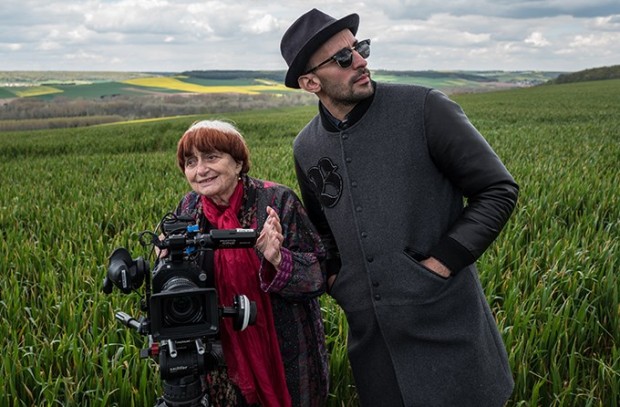“Chance has always been my best assistant,” says veteran director Agnes Varda to her newest collaborator, JR in the charming documentary “Faces Places.” Adhering to this piece of advice, the duo takes a laissez-faire approach to their photographic journey through the French countryside. Their mission is to not only take pictures of the faces and places they discover, but to plaster those enormous images across buildings or whatever else that strikes their fancy. The faces they document include a bell ringer, a café worker and the sole real-estate holdout of a historic street slated for demolition. The interactions between the artists, their subjects and the resulting artwork yield some of the year’s best sequences.
JR’s van, which looks like a giant camera, serves as both transport and photo lab. It’s an attention-getter at every stop, striking as unique a figure as its inhabitants. The 88-year old Varda, with her two tone hair and short stature, is a great visual complement to the much taller 33-year old JR, whose sunglasses and hat evoke Jean-Luc Godard. Godard would have been close to JR’s age when Varda knew him in the 60’s, so JR’s appearance feels like a rip in time, an embodiment of Varda’s memories of her French New Wave cohort. Like JR, Godard was notorious for not taking off his glasses, but as a gift to Varda, he did so for a short film she created. JR acknowledges the similarities but will honor no such request. In the beautiful masterstroke that ends the film, the two men symbolically merge in one indelible, bittersweet final image.
“Faces Places” explores the art of looking and the response to what is seen. The directors’ camera holds on certain shots a bit longer than expected, exposing the humanity of the faces and places it depicts. Varda’s own failing eyes play a major part in the film’s homestretch, when JR decides to place a huge photo of them on a freight train. The result becomes the defining image of the film—the director’s eyes chugging through the countryside, taking in the universe and enjoying everything it has to offer.

Continuing our cinematic journey through France: Fans of physics and fiery French femmes will have a field day with Serge Bozon’s freaky fantasy “Mrs. Hyde.” Isabelle Huppert plays Madame Géquil, a bland science teacher whose unruly class has as little respect for her as everyone else in her personal orbit. Her spouse Pierre (Jose Garcia) is a patronizing househusband and her boss has a penchant for damning her with the faintest of praise. Even her most promising student, Malik (Adda Senani), treats her coldly in public despite benefiting from her after school mentoring. Mme. Géquil career is also in jeopardy, as she is one review away from being terminated by the school board.
Just as things are looking most dire, Mme. Géquil is hit with a stroke of luck, or rather, by a bolt of lightning. This electrified kiss from the gods saddles her with another personality, the intense, raunchy and more confident Mrs. Hyde. The transformation does not go unnoticed: Suddenly, Mme. Géquil is flashing her breasts at her husband and impressing her students with dangerous experiments. She also glows in the dark before frying people to a crisp on the street. This is a feature, not a bug.
From its sitcom-style setup to its flame-out of a finale, “Mrs. Hyde” maintains a complete air of tonal nonchalance that some may find frustrating. For those wishing to connect the dots, however, Bozon drops some intriguing ideas about incontrovertible scientific fact versus the mutable nature of the human experience. For example, a scene where a law of physics protects a student from being electrocuted by 100,000 volts is mirrored in a scene where a potential victim is saved from a similar fate by appealing to Mrs. Hyde’s emotions.
In the dual roles inspired by Robert Louis Stevenson’s classic monster tale, Huppert is superb. Only she could pull off the film’s climax, perhaps the most intense physics lesson ever captured on film. Mme. Géquil—or is she fully Mrs. Hyde at this point?—teaches the tenets of Physics 101 as if her life depended on it. We’re privy to several unrelieved minutes of lecture, enough to send the physics-averse running for the exits. But if you do leave, you’ll miss the film’s hilarious and mysterious denouement. It plays out over the end credits like a preview for the next Marvel movie.

France, specifically Calais, also appears in the refugee documentary “Sea Sorrow.” The directorial debut of legendary actress and activist, Vanessa Redgrave, “Sea Sorrow” aims to inform the viewer about the refugee crisis going on in Europe. At times, it uses Redgrave’s own relocated childhood during WWII as a comparative unit of measure. During the bombing of London, 3-year old Redgrave was sent into the British countryside where she was taken in by residents of the town. The war soon found her, however, and the fiery imagery Redgrave describes in narration helped shape her lifelong passion to fight for numerous causes.
“Sea Sorrow” puts me in a very uncomfortable position, because though the film’s heart is in the right place and its cause is relevant and important, I have to report that the film is astonishingly bad. It is a poorly edited jumble of television news clips, impromptu speeches by famous actors and sudden forays into Shakespeare, the writer who gives the film its title. Ralph Fiennes and Emma Thompson show up suddenly to do recitations while Redgrave talks directly to us while superimposed over images.
“Sea Sorrow” doesn’t give its subjects the bandwidth to speak for themselves, though it starts off promisingly with several people telling harrowing stories of their escape into exile. Redgrave identifies each person, giving the impression we will see them again, or at least follow their stories. But we never do. Instead, their agency is replaced by a guilt-inducing tone that reflects one of those old Sally Struthers commercials for ”Save the Children.” I wanted less footage of Redgrave and her cronies campaigning for these people and more of their actual stories.
Redgrave did a Q&A after the press screening, where she said she treated the film as if it were a poem. Without being asked, she also explained the shiny image that appeared every three minutes onscreen in unrecognizable close-up. This gimmick is so annoying that I wrote “what the hell is this shiny curtain that keeps showing up?” in my notes. Turns out it’s a thermal blanket, a device that protects from excessive heat or cold. “Sea Sorrow” uses it for symbolic rather than practical purposes (like telling us that our donated money helps buy these items, for example), making its repeated appearances a perfect metaphor for the film’s execution.
“Sea Sorrow” gives us symbols, speeches and a sense of shame that, in more skillful hands, might have actually been effective. I can’t deny the good intentions of its director, but good intentions don’t always translate into good filmmaking.












